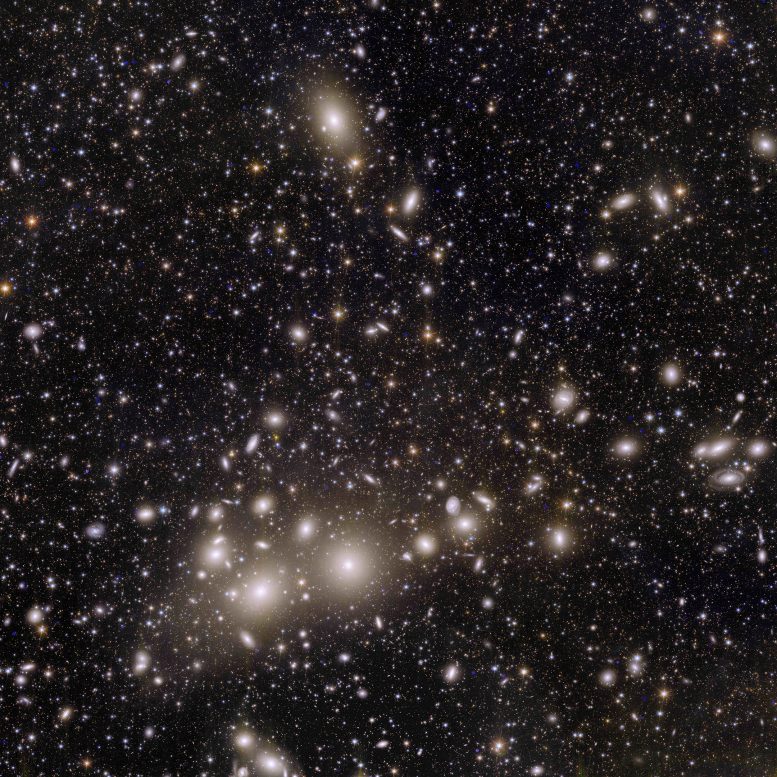
The Euclid space telescope’s snapshot of the Perseus Cluster and distant galaxies illuminates the role of dark matter in the cosmos. This allows astronomers to investigate the cosmic web, detect elusive dwarf galaxies, and analyze weak lensing effects, advancing our understanding of dark matter and dark energy. Credit: ESA/Euclid/Euclid Consortium/NASA, image processing by J.-C. Cuillandre (CEA Paris-Saclay), G. Anselmi, CC BY-SA 3.0 IGO
Euclid’s groundbreaking image of the Perseus Cluster and myriad distant galaxies offers new insights into dark matter’s influence on the Universe’s structure and the ongoing mystery of dark energy.
This incredible snapshot from Euclid is a revolution for astronomy. The image shows 1000 galaxies belonging to the Perseus Cluster, and more than 100,000 additional galaxies further away in the background, each containing up to hundreds of billions of stars.
Unveiling Previously Unseen Galaxies
Many of these faint galaxies were previously unseen. Some of them are so distant that their light has taken 10 billion years to reach us. By mapping the distribution and shapes of these galaxies, cosmologists will be able to find out more about how dark matter shaped the Universe that we see today.
Exploring the Perseus Cluster
This is the first time that such a large image has allowed us to capture so many Perseus galaxies in such a high level of detail. Perseus is one of the most massive structures known in the Universe, located ‘just’ 240 million light-years away from Earth, containing thousands of galaxies, immersed in a vast cloud of hot gas. Astronomers demonstrated that galaxy clusters like Perseus can only have formed if dark matter is present in the Universe.
Dark Matter and the Cosmic Web
“If no dark matter existed, galaxies would be distributed evenly throughout the Universe,” explains Euclid Consortium scientist Jean-Charles Cuillandre of the CEA Paris-Saclay in France.
Gravity causes dark matter to form filamentary structures often referred to as the cosmic web. The crossing points between dark matter filaments cause galaxies to stick close together, creating a cluster. The cosmic web permeates the whole Universe, and similar structures are seen way beyond Perseus, as far as 12 million light-years away.
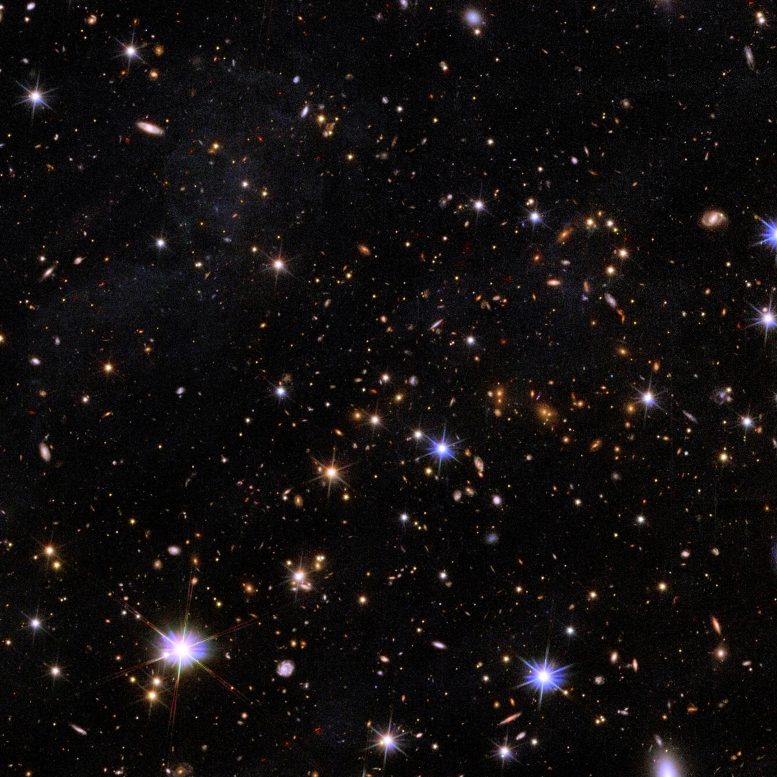
This cutout from Euclid’s full view of the Perseus Cluster is at the high resolution of the VIS instrument. This is nine times better than the definition of NISP that was selected for the full view; this was done for the practical reason of limiting the format of the full image to a manageable size for downloading. The cutout fully showcases the power of Euclid in obtaining extremely sharp images over a large region of the sky in one single pointing. Although this image represents only a small part of the entire colour view, the same quality as shown here is available over the full field. Credit: ESA/Euclid/Euclid Consortium/NASA, image processing by J.-C. Cuillandre (CEA Paris-Saclay), G. Anselmi, CC BY-SA 3.0 IGO
The Quest for Dwarf Galaxies
Many galaxies in this cluster are already known, but Jean-Charles and his colleagues are interested in the tiny galaxies that were not visible in images from other telescopes.
“We want to see the extremely faint and small galaxies, called dwarf galaxies. They are dominated by older stars that shine in infrared light. According to cosmological simulations, the Universe should contain many more dwarf galaxies than we have found so far. With Euclid, we will be able to see them, if they indeed exist in such a large number as predicted.”
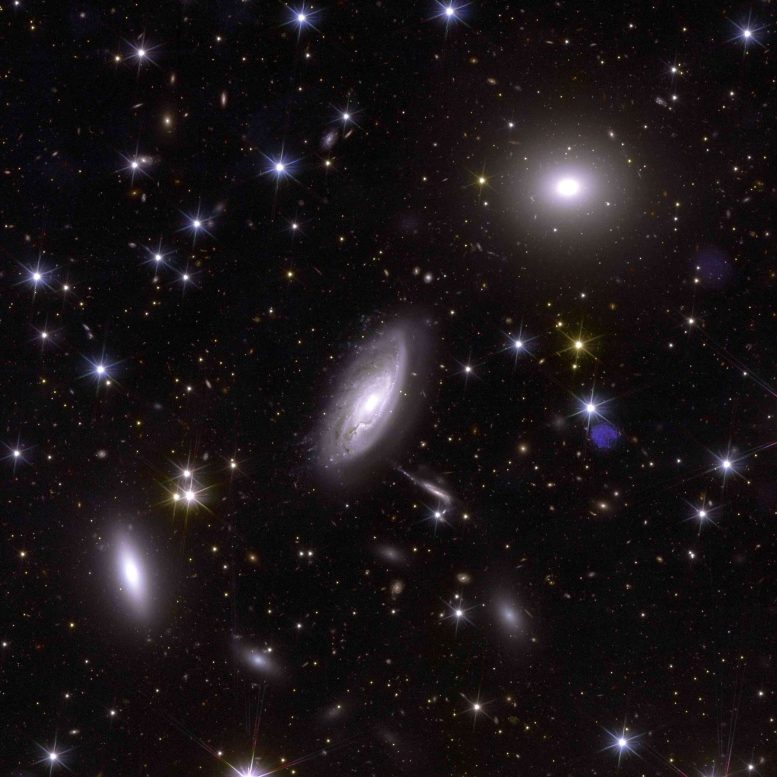
This cutout from Euclid’s full view of the Perseus Cluster is at the high resolution of the VIS instrument. This is nine times better than the definition of NISP that was selected for the full view; this was done for the practical reason of limiting the format of the full image to a manageable size for downloading. The cutout fully showcases the power of Euclid in obtaining extremely sharp images over a large region of the sky in one single pointing. Although this image represents only a small part of the entire colour view, the same quality as shown here is available over the full field. Credit: ESA/Euclid/Euclid Consortium/NASA, image processing by J.-C. Cuillandre (CEA Paris-Saclay), G. Anselmi, CC BY-SA 3.0 IGO
Analyzing Galaxy Shapes and Weak Lensing
Astronomers also want to study the shapes of these faint galaxies within the cluster and in the background, because their apparent distortions will tell us how dark matter is distributed within the cluster and in the Universe as a whole. This effect is called weak lensing.
In this image, we see over 100,000 galaxies beyond the Perseus Cluster, of which over 50,000 can be used to study weak lensing. Euclid’s entire sky survey will be 30,000 times larger than this image, resulting in billions of galaxies being imaged.
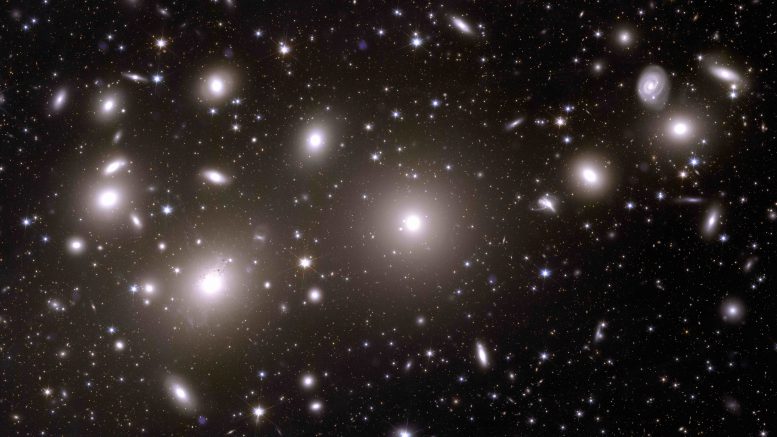
This cutout from Euclid’s full view of the Perseus Cluster is at the high resolution of the VIS instrument. This is nine times better than the definition of NISP that was selected for the full view; this was done for the practical reason of limiting the format of the full image to a manageable size for downloading. The cutout fully showcases the power of Euclid in obtaining extremely sharp images over a large region of the sky in one single pointing. Although this image represents only a small part of the entire color view, the same quality as shown here is available over the full field. Credit: ESA/Euclid/Euclid Consortium/NASA, image processing by J.-C. Cuillandre (CEA Paris-Saclay), G. Anselmi, CC BY-SA 3.0 IGO
The Intra-Cluster Light and Its Implications
Another important feature in Euclid’s image of Perseus is the faint light between galaxies in the core of the cluster. This light is caused by free floating stars, a consequence of galaxies interacting with each other. By studying this intra-cluster light, scientists can trace back the history of the cluster. It also shows how dark matter is distributed.
Mapping Dark Matter and Dark Energy
Euclid will observe numerous galaxy clusters like Perseus, all distributed along the cosmic web of dark matter and thereby providing a 3D view of the dark matter distribution in our Universe. The map of the distribution of galaxies over cosmic time will also teach us about dark energy, which accelerates the expansion of the Universe.
See more of Euclid’s First Images.



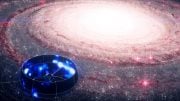




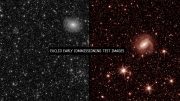
Be the first to comment on "Galactic Wonders Unveiled: Euclid’s Deep Dive Into the Perseus Cluster"